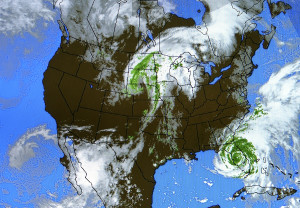 Most of us check the weather reports on a regular basis. For many, the weather is an important factor in our everyday lives, especially when we are required to cross the country to get to our destination. Oftentimes, a trucker will start their run in sunny California, then find themselves dodging thunderstorms and tornadoes in the Great Plains, only to end the run during a blizzard on the East Coast. Many truckers have hair-raising stories to tell about their encounters with the weather before the Internet was created, which gave us access to instant information. We even know some of the jargon the weather forecasters use, too. If you ask someone what the “Jet Stream” is, most likely they will reply that it is that thin band on the weather map that helps to forecast weather fronts. That is true, but it is so much more than that. Picture a river of water, that flows at a certain rate, according to the amount of water that it has to move – it is stronger in the middle of the stream and weaker toward the banks. Well, the Jet Stream is a “river” of tremendous winds in the upper atmosphere that typically flows from west to east, but it can also flow from north to south. In the Northern Hemisphere, which includes the United States, the Polar Jet Stream is more forceful and can greatly influence the weather patterns, especially in the winter months. Like a winding river, the Jet Stream has peaks and
Most of us check the weather reports on a regular basis. For many, the weather is an important factor in our everyday lives, especially when we are required to cross the country to get to our destination. Oftentimes, a trucker will start their run in sunny California, then find themselves dodging thunderstorms and tornadoes in the Great Plains, only to end the run during a blizzard on the East Coast. Many truckers have hair-raising stories to tell about their encounters with the weather before the Internet was created, which gave us access to instant information. We even know some of the jargon the weather forecasters use, too. If you ask someone what the “Jet Stream” is, most likely they will reply that it is that thin band on the weather map that helps to forecast weather fronts. That is true, but it is so much more than that. Picture a river of water, that flows at a certain rate, according to the amount of water that it has to move – it is stronger in the middle of the stream and weaker toward the banks. Well, the Jet Stream is a “river” of tremendous winds in the upper atmosphere that typically flows from west to east, but it can also flow from north to south. In the Northern Hemisphere, which includes the United States, the Polar Jet Stream is more forceful and can greatly influence the weather patterns, especially in the winter months. Like a winding river, the Jet Stream has peaks and  troughs of winds that range from 110 to 250 miles per hour (or more). These rivers of winds were first discovered by airplane pilots during WWII – the bombers would use the Jet Stream to their advantage, picking up a tail wind when possible, to reach their home base quicker. But these rivers of winds, that are active from 20,000 to 50,000 feet in the atmosphere, can also be influenced by other elements, like volcanic eruptions. If the eruption is great enough – like the Eyujafjallajokull volcano in 2010 – it can and will ground airplanes, because the plumes of volcanic ash can reach the Jet Stream and be carried aloft. Also, the rotation of the earth’s axis moves the winds along. Throw into the recipe the cold and warm air fronts, the seasons, and the high and low pressures, and you begin to have an idea of just how complex that “thin band on the weather map” really is. Another interesting fact is that the Jet Stream is not only on the planet Earth, but it has also been sighted on the planets of Jupiter and Saturn. Now that is something to think about. Who knows, maybe there are alien “truckers” out there in the galaxy, checking the weather patterns, before their runs on Jupiter or Saturn!
troughs of winds that range from 110 to 250 miles per hour (or more). These rivers of winds were first discovered by airplane pilots during WWII – the bombers would use the Jet Stream to their advantage, picking up a tail wind when possible, to reach their home base quicker. But these rivers of winds, that are active from 20,000 to 50,000 feet in the atmosphere, can also be influenced by other elements, like volcanic eruptions. If the eruption is great enough – like the Eyujafjallajokull volcano in 2010 – it can and will ground airplanes, because the plumes of volcanic ash can reach the Jet Stream and be carried aloft. Also, the rotation of the earth’s axis moves the winds along. Throw into the recipe the cold and warm air fronts, the seasons, and the high and low pressures, and you begin to have an idea of just how complex that “thin band on the weather map” really is. Another interesting fact is that the Jet Stream is not only on the planet Earth, but it has also been sighted on the planets of Jupiter and Saturn. Now that is something to think about. Who knows, maybe there are alien “truckers” out there in the galaxy, checking the weather patterns, before their runs on Jupiter or Saturn!
Previous ArticleDark Angel
Next Article Drivers Under Attack
SharLeigh
SharLeigh has an inquisitive nature – she is interested in current events, history, science and many more subjects, including things that go bump in the night! Since 1997, SharLeigh has scoured the internet, looking for interesting, fun and timely topics covering all sorts of human-interest subjects for her articles from her home in Fontana, CA.
